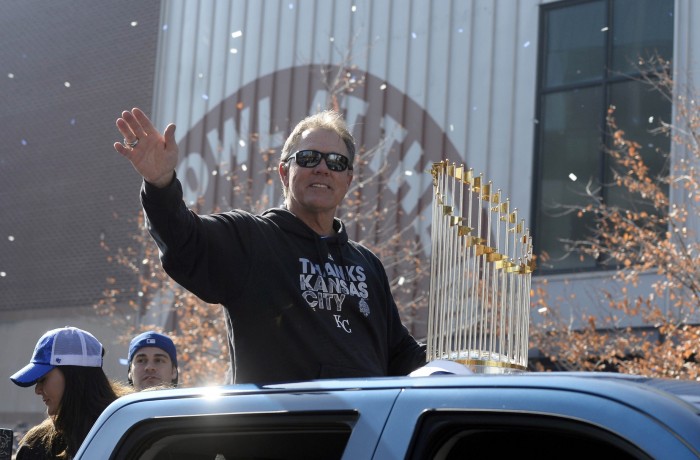Jerry Crasnick posted an article at ESPN on Friday suggesting that teams won’t be copying the Royals‘ free-swinging, contact-oriented team constructed around solid defense and a strong bullpen, rather than around middle-of-the-order sluggers and ace-level starting pitchers. There’s a perfectly good reason for that: most teams don’t play in cavernous parks like Kauffman Stadium that encourage contact and suppress power, and few teams will ever have a similar collection of players who both have excellent contact skills and play excellent defense.
This is a credit to the Royals’ players — while it’s tempting to think it might be easier to construct a team like this considering the exhorbitant sums top starters and sluggers fetch in free agency, there just aren’t that many players that have the all-around skillsets necessary to power a team like the Royals. Good luck finding too many quality two-way players like Lorenzo Cain, Alex Gordon and Salvador Perez or shutdown relievers like Greg Holland and Wade Davis. Usually by the time players like these reach free agency, either the league has caught on to the fact that their skillset is worthwhile, or they’ve already started their decline phase — particularly since pitcher velocity and position-player defense are usually the first skills to decline for each group.
But that doesn’t mean teams aren’t going to try to copy the way the Royals won, by losing for years, racking up tons of high draft picks, waiting for a wave of prospects to come around, and carefully spending to fill the few holes that remain. Of the Royals’ core players, Mike Moustakas (pick 1.2 in 2007), Eric Hosmer (pick 1.3 in 2008) and Alex Gordon (pick 1.2 in 2005) were all the fruits of selecting high in the draft after terrible seasons. Lorenzo Cain and Alcides Escobar were acquired in exchange for Zack Greinke, pick 1.6 in 2002.
From 2003 through 2008, the Royals had a payroll between $36 million and $67 million, ranking between 24th and 27th in Major League Baseball in all six seasons. This is when they drafted most of the core talent from their 2014 and 2015 playoff runs, or the players who were traded to improve the team around them. The Royals slightly increased their payroll in the latter part of the decade with ill-advised deals for Jose Guillen and Gil Meche, but in 2011, the Royals entered full Process mode and whittled their payroll down to a league-low $38 million. They then slowly built the payroll up as their young players moved up the salary scale, up to $64 million (26th) in 2012, $82 million (22nd) in 2013, $92 million (19th) in 2014, and fueled by their AL Pennant, $113 million in 2015 (13th).
You can’t deny the effectiveness of the Process. Everything that was supposed to happen for a small-market team to win happened. The prospects showed up, they grew together, the front office filled in the gaps, an exciting and improbable first playoff run then gave them the experience and confidence to bring the championship home a year later.
But this is part of the problem I’ve been writing about here for the past couple of months. The reason small-market teams are going to copy the Royals is because every other route to contention has been closed off. And this isn’t just about money — it’s about rules like the qualifying-offer system, revenue sharing, and caps on draft and international amateur spending that have made it impossible to take other routes to contention. Having to surrender draft picks for mid-level free agents makes it difficult to slowly build year-by-year, and the spending caps in the amateur market make it impossible to go above slot to keep top-tier talent coming in if a team improved (and improved its draft slot) slowly but steadily.
So, sure, teams probably aren’t going to “copy the Royals” in the sense Crasnick discusses. It’s going to be near impossible to cobble together a group of uniquely defensively talented contact hitters like the Royals had in 2014 and 2015. That’s what their scouts and system were good at identifying and developing, so that’s what came out, much like how the Brewers rose to contention in the late 2000s behind a roster filled with Jack Z Specials — young sluggers who could win despite their defensive deficiencies. But you can bet teams are going to copy Kansas City’s process — and they already have, in Houston, and to a lesser extent, on Chicago’s north side.
However, it can’t be forgotten that a critical part of this process is years and years — maybe a decade, maybe more — of losing. That would be just fine with most fans, I think, if it always worked out as cleanly as it did for the Royals. But it won’t, as we saw with the Brewers in 2008 and 2011. Next year isn’t always what it’s cracked up to be, and a talented core can disintegrate quickly. So to all the teams getting ready to copy the Royals and look to the future: Best of luck when your window finally comes, and don’t blink or you might miss it. Hopefully all the losses are worth it.
